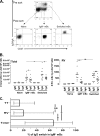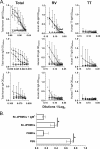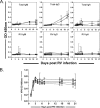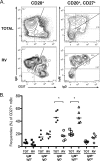Human rotavirus-specific IgM Memory B cells have differential cloning efficiencies and switch capacities and play a role in antiviral immunity in vivo
- PMID: 22855480
- PMCID: PMC3457288
- DOI: 10.1128/JVI.01466-12
Human rotavirus-specific IgM Memory B cells have differential cloning efficiencies and switch capacities and play a role in antiviral immunity in vivo
Abstract
Protective immunity to rotavirus (RV) is primarily mediated by antibodies produced by RV-specific memory B cells (RV-mBc). Of note, most of these cells express IgM, but the function of this subset is poorly understood. Here, using limiting dilution assays of highly sort-purified human IgM(+) mBc, we found that 62% and 21% of total (non-antigen-specific) IgM(+) and RV-IgM(+) mBc, respectively, switched in vitro to IgG production after polyclonal stimulation. Moreover, in these assays, the median cloning efficiencies of total IgM(+) (17%) and RV-IgM(+) (7%) mBc were lower than those of the corresponding switched (IgG(+) IgA(+)) total (34%) and RV-mBc (17%), leading to an underestimate of their actual frequency. In order to evaluate the in vivo role of IgM(+) RV-mBc in antiviral immunity, NOD/Shi-scid interleukin-2 receptor-deficient (IL-2Rγ(null)) immunodeficient mice were adoptively transferred highly purified human IgM(+) mBc and infected with virulent murine rotavirus. These mice developed high titers of serum human RV-IgM and IgG and had significantly lower levels than control mice of both antigenemia and viremia. Finally, we determined that human RV-IgM(+) mBc are phenotypically diverse and significantly enriched in the IgM(hi) IgD(low) subset. Thus, RV-IgM(+) mBc are heterogeneous, occur more frequently than estimated by traditional limiting dilution analysis, have the capacity to switch Ig class in vitro as well as in vivo, and can mediate systemic antiviral immunity.
Figures





Similar articles
-
Simultaneous assessment of rotavirus-specific memory B cells and serological memory after B cell depletion therapy with rituximab.PLoS One. 2014 May 12;9(5):e97087. doi: 10.1371/journal.pone.0097087. eCollection 2014. PLoS One. 2014. PMID: 24819618 Free PMC article.
-
Characterization of rotavirus specific B cells and their relation with serological memory.Virology. 2008 Oct 25;380(2):234-42. doi: 10.1016/j.virol.2008.08.004. Epub 2008 Sep 11. Virology. 2008. PMID: 18789807 Free PMC article.
-
Protective intestinal anti-rotavirus B cell immunity is dependent on alpha 4 beta 7 integrin expression but does not require IgA antibody production.J Immunol. 2001 Feb 1;166(3):1894-902. doi: 10.4049/jimmunol.166.3.1894. J Immunol. 2001. PMID: 11160237
-
The class of surface immunoglobulin on virgin and memory B lymphocytes.J Immunol. 1977 May;118(5):1806-15. J Immunol. 1977. PMID: 67148 Review.
-
IgM in microbial infections: taken for granted?Immunol Lett. 2009 Aug 15;125(2):79-85. doi: 10.1016/j.imlet.2009.06.003. Epub 2009 Jun 17. Immunol Lett. 2009. PMID: 19539648 Free PMC article. Review.
Cited by
-
Rapid Proliferation and Differentiation of a Subset of Circulating IgM Memory B Cells to a CpG/Cytokine Stimulus In Vitro.PLoS One. 2015 Oct 6;10(10):e0139718. doi: 10.1371/journal.pone.0139718. eCollection 2015. PLoS One. 2015. PMID: 26439739 Free PMC article.
-
Complexity of the human memory B-cell compartment is determined by the versatility of clonal diversification in germinal centers.Proc Natl Acad Sci U S A. 2015 Sep 22;112(38):E5281-9. doi: 10.1073/pnas.1511270112. Epub 2015 Aug 31. Proc Natl Acad Sci U S A. 2015. PMID: 26324941 Free PMC article.
-
Simultaneous assessment of rotavirus-specific memory B cells and serological memory after B cell depletion therapy with rituximab.PLoS One. 2014 May 12;9(5):e97087. doi: 10.1371/journal.pone.0097087. eCollection 2014. PLoS One. 2014. PMID: 24819618 Free PMC article.
-
Immunoinformatics Approach for Epitope-Based Peptide Vaccine Design and Active Site Prediction against Polyprotein of Emerging Oropouche Virus.J Immunol Res. 2018 Oct 8;2018:6718083. doi: 10.1155/2018/6718083. eCollection 2018. J Immunol Res. 2018. PMID: 30402510 Free PMC article.
-
Optimisation of ex vivo memory B cell expansion/differentiation for interrogation of rare peripheral memory B cell subset responses.Wellcome Open Res. 2017 Oct 5;2:97. doi: 10.12688/wellcomeopenres.11386.2. eCollection 2017. Wellcome Open Res. 2017. PMID: 29588920 Free PMC article.
References
-
- Agematsu K, Hokibara S, Nagumo H, Komiyama A. 2000. CD27: a memory B-cell marker. Immunol. Today 21:204–206 - PubMed
-
- Angel J, Franco MA, Greenberg HB. 2007. Rotavirus vaccines: recent developments and future considerations. Nat. Rev. Microbiol. 5:529–539 - PubMed
-
- Aranburu A, et al. 2010. TLR ligation triggers somatic hypermutation in transitional B cells inducing the generation of IgM memory B cells. J. Immunol. 185:7293–7301 - PubMed
-
- Bernasconi NL, Traggiai E, Lanzavecchia A. 2002. Maintenance of serological memory by polyclonal activation of human memory B cells. Science 298:2199–2202 - PubMed
Publication types
MeSH terms
Substances
Grants and funding
LinkOut - more resources
Full Text Sources
Miscellaneous

